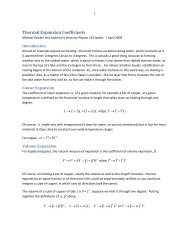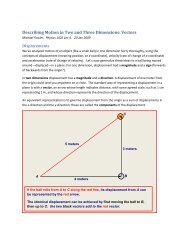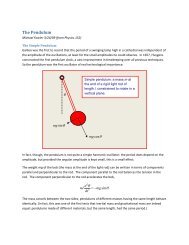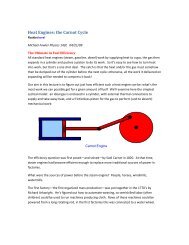x - Galileo and Einstein
x - Galileo and Einstein
x - Galileo and Einstein
- No tags were found...
You also want an ePaper? Increase the reach of your titles
YUMPU automatically turns print PDFs into web optimized ePapers that Google loves.
Waves IIPhysics 2415 Lecture 26Michael Fowler, UVa
Today’s Topics• The wave equation• Energy <strong>and</strong> power of waves• Superposition• St<strong>and</strong>ing waves as sums of traveling waves• Fourier series
Harmonic Waves• A simple harmonic wave has sinusoidal form:Amplitude AWavelength • For a string along the x-axis, this is localdisplacement in y-direction at some instant.• For a sound wave traveling in the x-direction,this is local x-displacement at some instant.
Traveling Wave• Experimentally, a pulse traveling down a stringunder tension maintains its shape:• Mathematically, this means the perpendiculardisplacement y stays the same function of x,but with an origin moving at velocity v:vty f x,t f x vt
Traveling Harmonic Wave• A sine wave of wavelength , amplitude A,traveling at velocity v has displacementy2y Asin x vt Asinkx t 0xvt
Harmonic Wave Notation• A sine wave of wavelength , amplitude A,traveling at velocity v has displacement2y Asin x vt • This is usually written y Asinkx t, wherethe “wave number” k 2 / <strong>and</strong> vk.• As the wave is passing, a single particle of stringhas simple harmonic motion with frequency ωradians/sec, or f = ω/2 Hz. Note that v = f
ConcepTest 15.5 Lunch TimeMicrowaves travel with the speed oflight, c = 3 10 8 m/s. At a frequencyof 10 GHz these waves cause the watermolecules in your burrito to vibrate.What is their wavelength?1 GHz = 1 Gigahertz = 10 9 cycles/sec1) 0.3 mm2) 3 cm3) 30 cm4) 300 m5) 3 kmHOH
ConcepTest 15.5 Lunch TimeMicrowaves travel with the speed oflight, c = 3 10 8 m/s. At a frequencyof 10 GHz these waves cause the watermolecules in your burrito to vibrate.What is their wavelength?1 GHz = 1 Gigahertz = 10 9 cycles/sec1) 0.3 mm2) 3 cm3) 30 cm4) 300 m5) 3 kmWe know v wave =vso = =fT= f /3 10 8 m s10 10 9 Hz = 3 10 −2 m = 3 cmOHH
The Wave Equation• The wave equation is just Newton’s law F = maapplied to a little bit of the vibrating string:• The tiny length of string shown in red has lengthm = dx, is accelerating in the y-direction with2acceleration 2a f x, t / t, <strong>and</strong> the force F isthe sum of the tensions at the two ends of thebit of string, which don’t cancel because they’renot parallel. Animation!
The Wave Equation• The y-direction component of the tension T at thefront end of the string is just T multiplied by theslope (for small amplitudes), .Tf x dx, t / x• At the back end, T points backwards, so thedownward component is T f x, t / x.• The total y-direction force is therefore 2 2F Tf x dx, t / x Tf x, t / x T f x, t / xdx
Wave Equation• We’re ready to write F = ma for that bit of string: 2 2F Tf x dx, t / x Tf x, t / x T f x, t / x dx2• m = dx, 2a f x, t / t.• Putting it all together:2 2 f f2 2x T t• Since this is nothing but Newton’s second law, itmust be true for any wave on a string.
Traveling Wave Equation• Recall that from observation a traveling wavehas the form y f x vt.• From the chain rule, for that function 2 2f f x vtf f f v, vt x vt t x t x22 2• Comparing this with the wave equation, wesee that 2 2 2 f f 1 f 2 2 2 2x T t v tThis proves that vT / .
ConcepTest 15.6a Wave Speed IA wave pulse can be sent down arope by jerking sharply on the freeend. If the tension of the rope isincreased, how will that affect thespeed of the wave?1) speed increases2) speed does not change3) speed decreases
ConcepTest 15.6a Wave Speed IA wave pulse can be sent down arope by jerking sharply on the freeend. If the tension of the rope isincreased, how will that affect thespeed of the wave?1) speed increases2) speed does not change3) speed decreasesThe wave speed depends on the square rootof the tension, so if the tension increases,then the wave speed will also increase.
ConcepTest 15.6b Wave Speed IIA wave pulse is sent down a rope ofa certain thickness <strong>and</strong> a certaintension. A second rope made of thesame material is twice as thick, but isheld at the same tension. How willthe wave speed in the second ropecompare to that of the first?1) speed increases2) speed does not change3) speed decreases
ConcepTest 15.6b Wave Speed IIA wave pulse is sent down a rope ofa certain thickness <strong>and</strong> a certaintension. A second rope made of thesame material is twice as thick, but isheld at the same tension. How willthe wave speed in the second ropecompare to that of the first?1) speed increases2) speed does not change3) speed decreasesThe wave speed goes inversely as the square root of themass per unit length, which is a measure of the inertia ofthe rope. So in a thicker (more massive) rope at the sametension, the wave speed will decrease.
ConcepTest 15.6c Wave Speed IIIA length of rope L <strong>and</strong> mass M hangsfrom a ceiling. If the bottom of therope is jerked sharply, a wave pulsewill travel up the rope. As the wavetravels upward, what happens to itsspeed? Keep in mind that the rope isnot massless.1) speed increases2) speed does not change3) speed decreases
ConcepTest 15.6c Wave Speed IIIA length of rope L <strong>and</strong> mass M hangsfrom a ceiling. If the bottom of therope is jerked sharply, a wave pulsewill travel up the rope. As the wavetravels upward, what happens to itsspeed? Keep in mind that the rope isnot massless.1) speed increases2) speed does not change3) speed decreasesThe tension in the rope is not constant in the case of amassive rope! The tension increases as you move uphigher along the rope, because that part of the rope hasto support all of the mass below it! Because thetension increases as you go up, so does the wavespeed.
Harmonic Wave Energy• Writing the wave y Asinkx twhereremember k 2 / , vkit’s clear that atany fixed point x a bit of string dx is oscillating up<strong>and</strong> down in simple harmonic motion withamplitude A <strong>and</strong> frequency f = ω/2 Hz.• The energy of that bit dx is all kinetic when y = 0,( kx = t), the y-velocity at that instant isv y t A kx t A/ cos so the total energy in dx is1 2 12 22mv2dx A .
Harmonic Wave Energy• The total energy in dx is1 2 12 22mv2dx A ,1 2 2so in length L the wave energy is .2LA• Imagine now a group of waves, choose length v, movingto the right at speed v (passes you in just one second!):v m/secv• The power delivered by the waves is the energy passinga fixed point per second—that isP vA vA f122 2 2 222
The Wave Equation <strong>and</strong> Superposition• If you have two solutions to the wave equation,y = f(x,t) <strong>and</strong> y = g(x,t), then y = f + g is also asolution to the wave equation!• This can be checked with the actual equation:2 2 2 2 f g f g 1 f 1 g 1 f g 2 2 x x x v t v t v t2 2 2 2 2 2 2 2 2• Differential equations with this property arecalled “linear”. It means you can build up anyshape wave from harmonic waves.
A Harmonic Wave Hits a Wall…• When a wave hits a wall, the energy <strong>and</strong> waveform are reflected, <strong>and</strong> must be added to theincoming wave.• What does this look like? Let’s take the caseof a wave on a string, the string fixed at oneend…• Here it is…
Harmonic Wave AdditionTwo harmonic waves of the same wavelength<strong>and</strong> amplitude, but moving in oppositedirections, add to give a st<strong>and</strong>ing wave.Notice the st<strong>and</strong>ing wave also satisfies f = v, even though it’s not traveling!
St<strong>and</strong>ing Wave Formula• To add two traveling waves of equal amplitude<strong>and</strong> wavelength moving in opposite directions,we use the trig formula for addition of sines: A B A Bsin Asin B2sin cos 2 2 • Applying this, Asin kx t Asin kx t 2Asin kx cost• Allowed values of k are given bywhere is the string length.k , 2 , 3
Harmonic Wave on String• The amplitude must always be zero at theends of the string. From v = f, the lowestfrequency note (the fundamental, or firstharmonic) has the longest allowedwavelength: = 2.• The second harmonic has = :
Clicker Question• For st<strong>and</strong>ing waves of equal amplitude onidentical strings at the same tension, one stringvibrating in the first harmonic mode, the otherthe second harmonic, the energy in the secondharmonic string is:• A. twice that in the first harmonic string• B. four times…• C. equal to…
Clicker Answer• For st<strong>and</strong>ing waves of equal amplitude onidentical strings at the same tension, one stringvibrating in the first harmonic mode, the otherthe second harmonic, the energy in the secondharmonic string is:• A. twice that in the first harmonic string• B. four times…• C. equal to…E122 2LA
Nodes <strong>and</strong> Antinodesx = 0nodeantinodex = The st<strong>and</strong>ing wave has formFor a pure note on a string with fixed ends,At a node, the string never moves:2xy x, t Asin kx cost Asin cos 2ft2 2 , ,3,2x1 3sin 0, x 0,2, , 2,
Clicker Question• The tension in a guitar string of fixed length isincreased by 10%. How does that change thewavelength of the second harmonic?• A. It increases by 10%• B. It increases by about 5%• C. It decreases by 10%• D. it decreases by about 5%• It stays the same.
Clicker Answer• The tension in a guitar string of fixed length isincreased by 10%. How does that change thewavelength of the second harmonic?• A. It increases by 10%• B. It increases by about 5%• C. It decreases by 10%• D. it decreases by about 5%• It stays the same: it’s just the length of the string!
Fourier SeriesWe can also build up any type of periodic wave by addingharmonic waves with the right amplitudes—this is called“Fourier analysis”: in music, it’s building up a complex notefrom its harmonics: here’s a triangle (formed by pulling aninstrument string up at the midpoint then letting go?).
Pulse EncounterIt’s worth seeing how two pulses traveling in oppositedirections pass each other:














